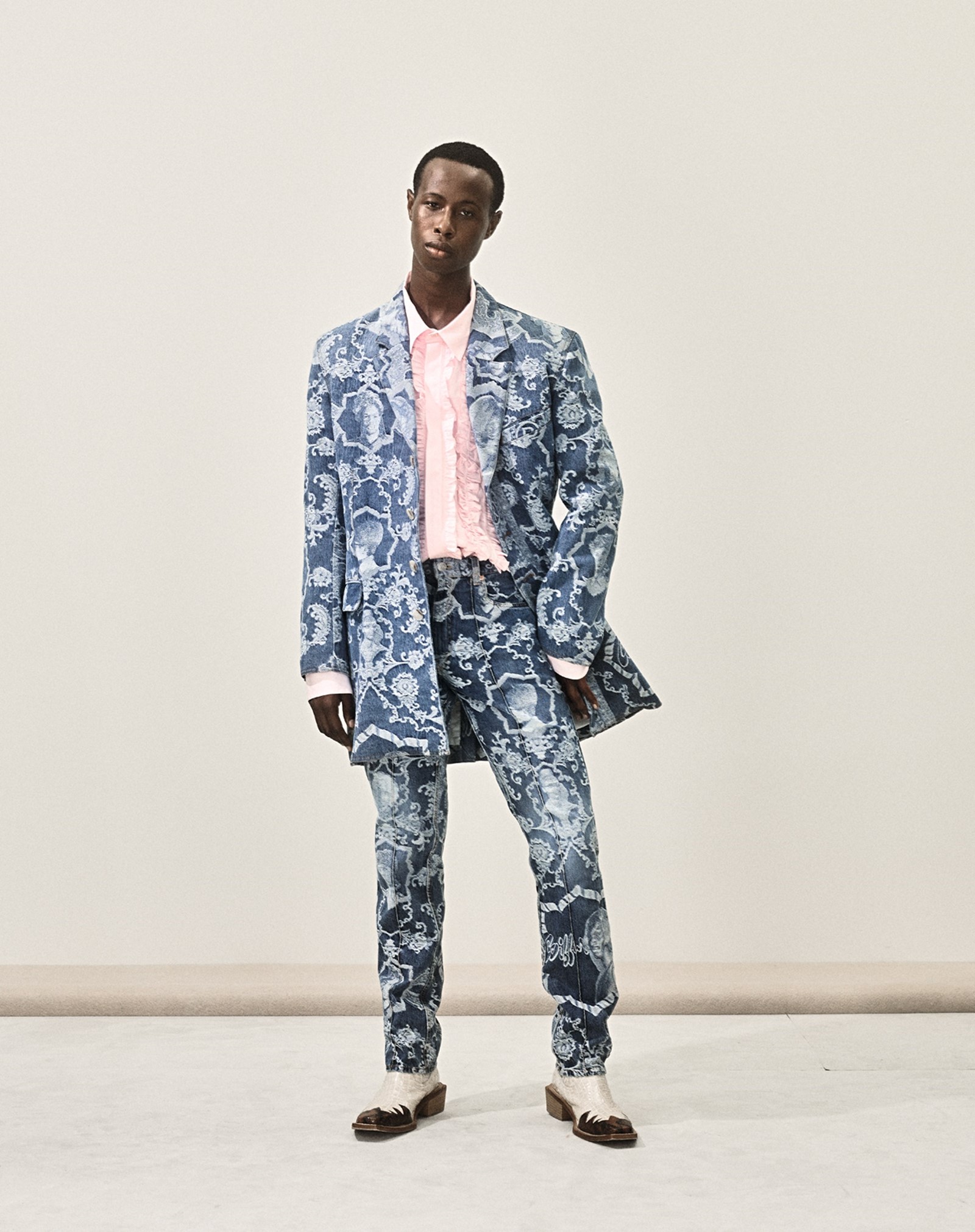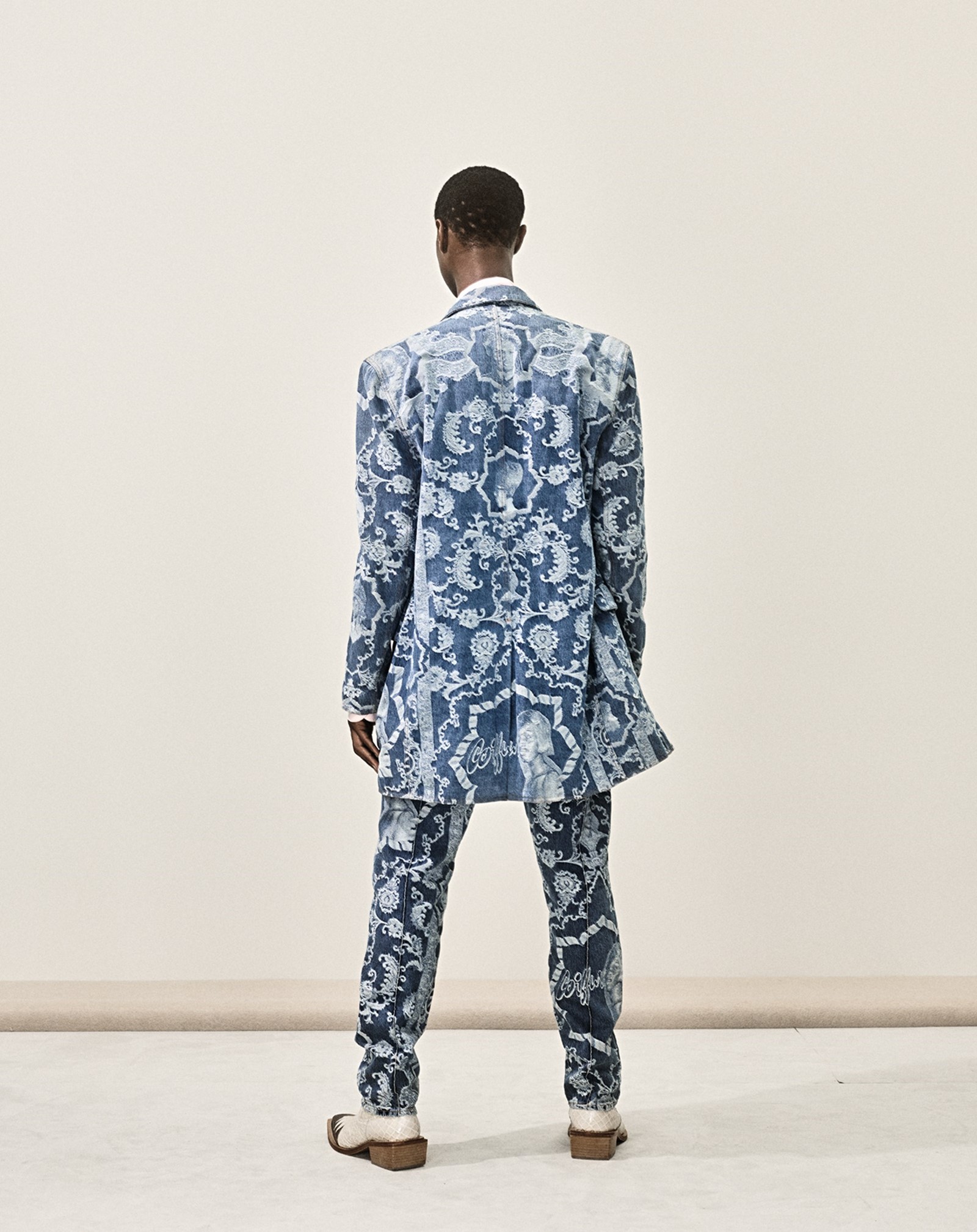Martine Rose is contradictorily interested in communities and the individual. She’s both an outsider and an insider, a loner and happy to be part of a group. But maybe that’s part of the industry, too, which is built on freaks and geeks. It’s usually the unfashionable ones from school who somehow make it in fashion. “Fashion is about outsiders, and I’ve always been attracted to outsiders, alternative people,” Rose says. “It’s definitely where all the freaks end up. But then, within that, it creates its own sort of conformity.” Her menswear label, which she has been designing under her own name since 2007, bears out the former while challenging the latter. Her clothes have an appeal often touted as cultish, which is sometimes synonymous with difficult: she proposes new proportions, different fabrics, twists and turns around silhouettes. Not everyone can wear it. “I don’t get offended if it’s not everyone’s thing at all,” she says. “It’s really not supposed to be.” Rose is gregarious, friendly, warm – she doesn’t strike you as a designer trying to be tricky. Nevertheless, she is one who resolutely refuses to play by anyone’s rules. “I think I’m, for lack of a better word, rebellious by nature,” Rose says. “Since I was really small, I’ve never really liked the idea of mass anything. If I felt that lots of people were doing one thing, I would absolutely go the other way.”
And so, Rose has. Now 40, she has spent much of her career bucking expectations – with varying degrees of success, at least in the material sense. Her label rose and fell, was picked up by retailers and dropped. She skipped a bunch of seasons – only finding financial stability to accompany general critical acclaim in the half decade since 2015. It is very much an old-school fashion story – especially in London fashion – one that many designers today circumvent by compromising, cutting corners and, arguably, selling out. Rose isn’t into that. “I went to see an Ibsen play when I was about 17, An Enemy of the People,” she says. “It’s basically about the danger of mass – of the mindless mob. That there is no thought and there’s something inherently dangerous about mob mentality – and it really struck a chord with me. I’d always felt like that.”
A simplistic reflection is Rose’s reticence to join the cacophony of seasonal catwalk shows. For Spring/Summer 2015, instead of showing a full collection she presented a single look – a concise and precise statement of what she had to say. Other times she oscillates between still images and runway shows, finding power in the quiet contemplation of the former and the dynamic energy of the latter. Recently, when showing on catwalks, Rose has chosen unconventional settings. Hers have snaked through the stalls of a covered market in Tottenham, close to her studio, as well as around an indoor climbing centre just around the corner, and down St Leonard’s Square, a cul-de-sac in Chalk Farm, north London. “That wasn’t my road,” Rose says, correcting assumptions made. “It’s not like I hung out or grew up there or anything like that. It just had a community spirit that I found compelling.” Her Autumn/Winter 2020 show was staged in the primary school that her daughter Valentine, now five, attends. “It’s where I go every day to pick her up,” Rose says, simply. It came across as heartfelt, real, intimate and intensely personal – as do her clothes.
The idea of communities was what initially drew Rose into fashion. “I wasn’t one of those kids who was making stuff,” Rose says. “But as an outsider, fashion was where I felt most aligned with people. That and music. I always saw fashion as part of culture. Less high-end catwalk stuff, which wasn’t on my radar at all, but much more the clothes that I saw my sister wearing, which was Pam Hogg, Christopher Nemeth, Junior Gaultier, Helen Storey.” Rose’s sister, Michelle, is 15 years her senior – glamorous, Vogue-reading. Her mother Sonia was a nurse and her father Clifford, a one-time Black Panther, was an accountant. “My sister was my everything,” says Rose, who would crouch on her bed, watching her get ready for nights out. Michelle inspired her younger sibling to study fashion at Middlesex University; in 2002, Rose began a label, LMNOP, with a friend, Tamara Rothstein, now the stylist who works on her shows. “I was the youngest in my extended family of cousins, and I just used to watch them all get ready to go out,” Rose says. “I loved the tribalism of it. It was like this access that I had to this other world. And I just could not wait to get there.”


Rose’s work has focused not on the cult of a designer’s personality, but rather the personalities of cults around her: music subcultures, rave and skaters, of belonging, somewhere and somehow, to a group. She has offered her own takes on football kits – bicoloured, her name taking the place of the team’s or maybe even a sponsor’s logo, made of the same kind of slithery polyester jacquard as an Arsenal or Chelsea kit. Rose’s subversion of branding is, in a sense, about communities, too: do you wear Adidas, do you wear Nike? That says something about you, your social aspirations, your place in life.
Even ideas of corporate identity and religion have been rolled in – the latter, maybe most unconventionally of all. In 2015, Rose started working alongside Demna Gvasalia as a consultant for the menswear line of Balenciaga. For the house’s debut men’s show in June 2016, Gvasalia and Rose wanted to include authentic liturgical damasks and laces – real, just like those football kits. They were purchased from a supplier to the Holy See, sourced in Paris. Rose went to buy the fabrics herself. “It was quite intense,” she says. “And I had this jacket on that was so inappropriate. I bought a Lewis Leathers jacket from Camden Market, which had ‘Wankers’ written in Tipp-Ex on the back. I really didn’t know what to expect – but I didn’t expect actual fucking nuns to be working there. French or no French, I mean, it didn’t feel appropriate. So I took off my jacket and did this whole acting bit – ‘Oh yes, I’m just interested in some lace.’ Thank God for the language barrier. They couldn’t quite understand me, so I was sort of creeping around, vaguely pretending.” She buries her head in her hands at the memory, but she’s laughing. “It was just awful.”
That isn’t indicative of her time working at the house – a three-year period that amicably ended in 2018. The unconventional appointment began when Rose – heavily pregnant with her daughter – received a call from Gvasalia, Balenciaga’s then recently appointed creative director. He asked if Rose would consider consulting for Balenciaga. “It was a really fucking expensive hobby until I was 34,” says Rose, of fashion. “I was still working in bars, I was squatting. It didn’t become a feasible career until really far down the line, basically until Demna was like, ‘I like what you do. Do you want to come and do it here?’” Rose had never worked for another fashion brand. But she said yes – and, in doing so, an underground underdog went overground. If not mass, her Balenciaga gig was certainly evidence that her aesthetic has mass appeal. And not just within the cliquey, extreme cloisters of the fashion industry: guys in pubs and clubs wound up wearing Balenciaga’s logoed pieces, not least a hypebeast-friendly rework of the Bernie Sanders logo, originally shown in the label’s corporate-inspired Autumn/Winter 2017 menswear show. Ironically, Rose’s Balenciaga rip-off is now ripped off, in turn. It’s a twist I suspect she likes. Logo jacking is an idea Rose explores often, reworking other people’s identities, subverting their codes. Durex condoms, Bose, MTV. They’re reminiscent of the bootlegs common in rave and acid-house wear. But she also reworks the identities of the clothes she designs, hiking up waistbands, widening legs, mutating trainers. Nothing is what it may first appear.
Having worked at a storied, heavily archived house such as Balenciaga – and, arguably, having shifted the aesthetic of menswear over the past decade or so – was she conscious of making pieces that are going down in history, I ask. It sounds pretentious, but Rose doesn’t wrinkle her nose. “I don’t think about it as pretentious,” she says, carefully. “One of my favourite objects is a smiley acid-house T-shirt. It’s so thin, it’s so transparent, it’s like silk. It was from my cousin, he was really into acid house. I’ve had it since 1989. My mum banned me from wearing it – and I can’t wear it now, because it’s so transparent. But it’s so precious now. It’s been washed a billion times, and it’s become this beautiful, fragile thing. It represents, still, this moment in time that was important to me.” She pauses. “To think that anyone would hold onto something that I’ve made for 20 years and feel like it brings something to them, even if they don’t wear it ... I love that.”
This story appears in AnOther Magazine Autumn/Winter 2020, which is now on sale internationally.
